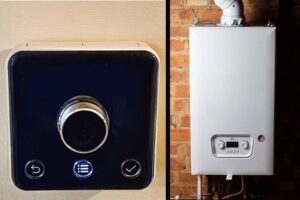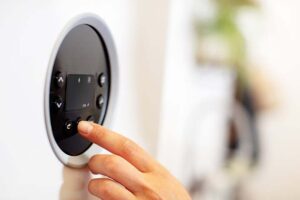Table of Contents
Most boilers use gas to heat water. In a combi boiler, the water goes straight to the hot taps or flows around the central heating and hot water tank. This produces too much heat and waste products that need to be safely released through a flue. Here, we will discuss what a boiler flue is, what it does, and some rules about where it can go.
What is a Boiler Flue?
The boiler flue is like the chimney for the boiler, but it doesn’t move smoke and soot away from the inside of the house. Instead, it mostly sends out carbon dioxide and water vapour.
But a boiler, especially one that isn’t working well, also makes small amounts of other substances that are even less desirable. Carbon monoxide is the most dangerous. It is a colourless and odourless gases that can harm you if you breathe it in. This is the reason every home should have both a carbon monoxide alarm and a smoke alarm. Nitrous gas is another possible by-product. It is not as dangerous, but it can make it hard to breathe.
If you put your boiler’s flue in the right place and follow the rules, all of these gases will be sent safely into the air, away from your home and any people who might be walking or driving by (if your wall meets a road or pavement outside).
How Does a Boiler Flue Work?
The flue is a pipework or duct that moves gases and hot air from the boiler’s combustion chamber to the outside.
In condenser boilers, the flue is actually part of the heating system because the hot gases start to warm the water that is coming back into the boiler. The hot burning gases are losing some of their heat energy, but the water coming in is getting warmer. The name “condensing” comes from the fact that the water vapour in the waste gases might even turn back into water. That’s one reason why condensing boilers work so well.
Most new boilers have a flue that runs straight through the wall that the boiler is attached to. The flues of outside boilers are set up differently so that they follow the rules. The flue of some boilers, especially those that burn oil, generally goes straight through the roof. If you put your boiler somewhere else on an outside wall, you will also need a vertical pipe.
A cover needs to go on top of a vertical flue to keep rain, leaves, snow, and other things that could block it from getting in. The gases must still be able to escape properly, though. Most horizontal flues don’t need a cover, but if you put one close to a tree, it’s a good idea to put a guard around it so leaves don’t get in. If the flue is stopped, the gases will have nowhere to go but back into the house, which is unsafe.
Boiler Flue Regulations
Because boiler flue gases can be dangerous and hot, there are important rules about how and where they can be put. These rules keep poisonous gases from coming back to your home or the houses of your neighbours. They also keep you, your neighbours, and everyone else safe from hot gases that could easily burn someone. For safety reasons, a flue must be at least three feet away from windows, air bricks, openings, walls, and the ground. Here are some examples of these distances:
- 2.1 m above ground level if it faces a public street or a road that is often used; 200 mm below the eaves (roof overhang); 75 mm below guttering, drain pipes, or soil pipes;
- 300 mm above the rooftop, roof, or ground
- If you have a flat or steep roof, place the flue 300 mm above the ceiling.
- 300 mm below, above, or next to a window, air vent, or other hole for ventilation
- 2000 mm below a Velux window (for a vent that goes up
Keep in mind that bigger clearances between the flue and the pertinent object may be necessary for more powerful boilers; the above clearance measurements are minimums for standard household boilers. Furthermore, kindly be advised that these rules are subject to review and modification.
Homeowners won’t need to be familiar with these safety precautions because a Gas-safe installer will be responsible for understanding and implementing them when installing a new boiler. If you reside in rental housing and believe your flue is missing, contact your landlord. It may put residents and onlookers in danger, and your landlord might even claim that a certified expert did not install the boiler.
Checking Your Boiler Flue
Checking your boiler flue every once in a while, is a good idea, especially if it’s been windy lately, like in the fall. They need to be taken off right away because leaves can get stuck inside them.
One of the most important parts of your regular service will be checking how well your flue works. The engineer will make sure that the flue is not blocked or hard to get to, and that it does its job properly and quickly. If you haven’t had your boiler cleaned and inspected in the last year, use our installer finder to find a fitter in your area. As the installer may only work with certain types, ensure you know what kind of boiler you have.
What Components Affect the Cost of a Boiler Flue?
A boiler flue’s price is based on its length and shape. A new device usually needs a new flue, so you will probably have to pay to have it replaced. It’s possible that your old flue will not work with the latest appliance, even though it may look and work fine.
Also, if you have to move your flue because you are adding it to your home, it will cost you, especially if it has to turn vertically and go out the roof. The vertical flues are harder to set up, so this is the case. For instance, a home’s roof isn’t always easy to get to, so a boiler engineer will need to get some scaffolding to get to the top. Often, roof tiles need to be moved too.
Summary
A boiler flue is a pipe that takes the waste gases from a boiler system outside the house. They can be square or round, and they can be placed horizontally or vertically.
Boiler flues must follow strict rules, and the exact sizes depend on the type of boiler. To find the right flue, always look at your boiler’s instructions. Debris can get stuck in flues, which could lead to a carbon monoxide leak in the home. In this case, you should quickly turn off the boiler and call a GSR engineer to come and look at it.









